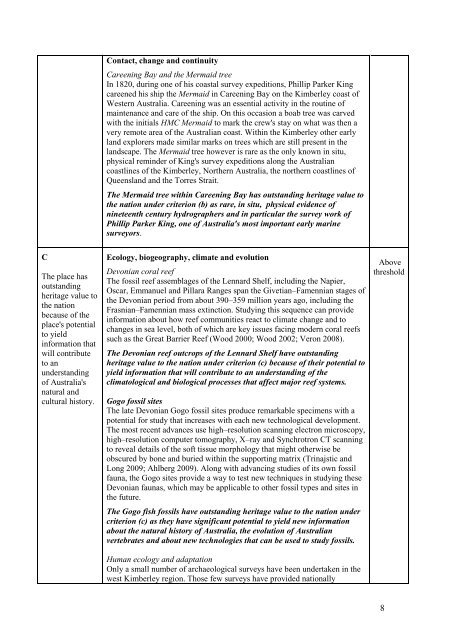WEST KIMBERLEY PLACE REPORT - Department of Sustainability ...
WEST KIMBERLEY PLACE REPORT - Department of Sustainability ...
WEST KIMBERLEY PLACE REPORT - Department of Sustainability ...
Create successful ePaper yourself
Turn your PDF publications into a flip-book with our unique Google optimized e-Paper software.
C<br />
The place has<br />
outstanding<br />
heritage value to<br />
the nation<br />
because <strong>of</strong> the<br />
place's potential<br />
to yield<br />
information that<br />
will contribute<br />
to an<br />
understanding<br />
<strong>of</strong> Australia's<br />
natural and<br />
cultural history.<br />
Contact, change and continuity<br />
Careening Bay and the Mermaid tree<br />
In 1820, during one <strong>of</strong> his coastal survey expeditions, Phillip Parker King<br />
careened his ship the Mermaid in Careening Bay on the Kimberley coast <strong>of</strong><br />
Western Australia. Careening was an essential activity in the routine <strong>of</strong><br />
maintenance and care <strong>of</strong> the ship. On this occasion a boab tree was carved<br />
with the initials HMC Mermaid to mark the crew's stay on what was then a<br />
very remote area <strong>of</strong> the Australian coast. Within the Kimberley other early<br />
land explorers made similar marks on trees which are still present in the<br />
landscape. The Mermaid tree however is rare as the only known in situ,<br />
physical reminder <strong>of</strong> King's survey expeditions along the Australian<br />
coastlines <strong>of</strong> the Kimberley, Northern Australia, the northern coastlines <strong>of</strong><br />
Queensland and the Torres Strait.<br />
The Mermaid tree within Careening Bay has outstanding heritage value to<br />
the nation under criterion (b) as rare, in situ, physical evidence <strong>of</strong><br />
nineteenth century hydrographers and in particular the survey work <strong>of</strong><br />
Phillip Parker King, one <strong>of</strong> Australia's most important early marine<br />
surveyors.<br />
Ecology, biogeography, climate and evolution<br />
Devonian coral reef<br />
The fossil reef assemblages <strong>of</strong> the Lennard Shelf, including the Napier,<br />
Oscar, Emmanuel and Pillara Ranges span the Givetian–Famennian stages <strong>of</strong><br />
the Devonian period from about 390–359 million years ago, including the<br />
Frasnian–Famennian mass extinction. Studying this sequence can provide<br />
information about how reef communities react to climate change and to<br />
changes in sea level, both <strong>of</strong> which are key issues facing modern coral reefs<br />
such as the Great Barrier Reef (Wood 2000; Wood 2002; Veron 2008).<br />
The Devonian reef outcrops <strong>of</strong> the Lennard Shelf have outstanding<br />
heritage value to the nation under criterion (c) because <strong>of</strong> their potential to<br />
yield information that will contribute to an understanding <strong>of</strong> the<br />
climatological and biological processes that affect major reef systems.<br />
Gogo fossil sites<br />
The late Devonian Gogo fossil sites produce remarkable specimens with a<br />
potential for study that increases with each new technological development.<br />
The most recent advances use high–resolution scanning electron microscopy,<br />
high–resolution computer tomography, X–ray and Synchrotron CT scanning<br />
to reveal details <strong>of</strong> the s<strong>of</strong>t tissue morphology that might otherwise be<br />
obscured by bone and buried within the supporting matrix (Trinajstic and<br />
Long 2009; Ahlberg 2009). Along with advancing studies <strong>of</strong> its own fossil<br />
fauna, the Gogo sites provide a way to test new techniques in studying these<br />
Devonian faunas, which may be applicable to other fossil types and sites in<br />
the future.<br />
The Gogo fish fossils have outstanding heritage value to the nation under<br />
criterion (c) as they have significant potential to yield new information<br />
about the natural history <strong>of</strong> Australia, the evolution <strong>of</strong> Australian<br />
vertebrates and about new technologies that can be used to study fossils.<br />
Human ecology and adaptation<br />
Only a small number <strong>of</strong> archaeological surveys have been undertaken in the<br />
west Kimberley region. Those few surveys have provided nationally<br />
Above<br />
threshold<br />
8
















